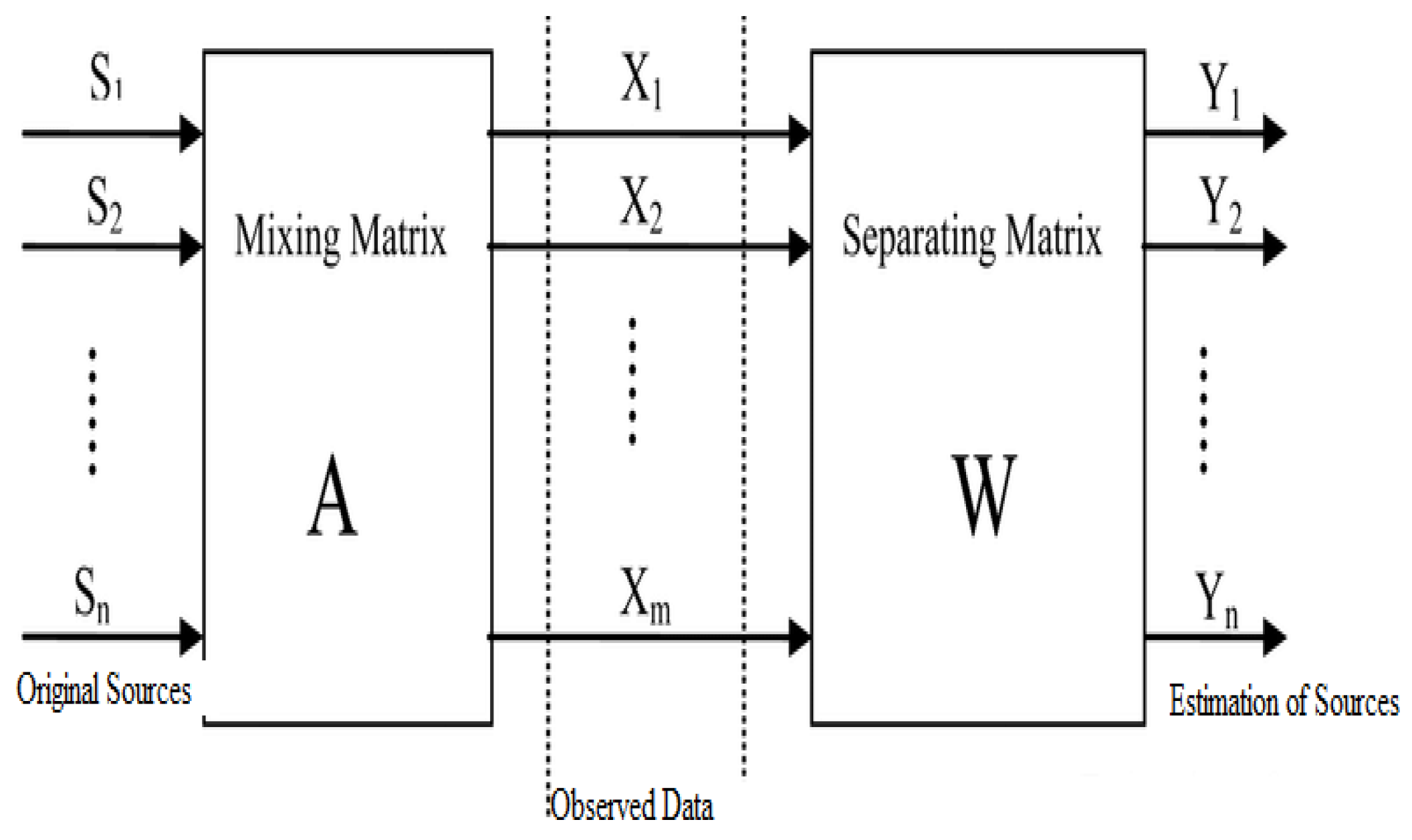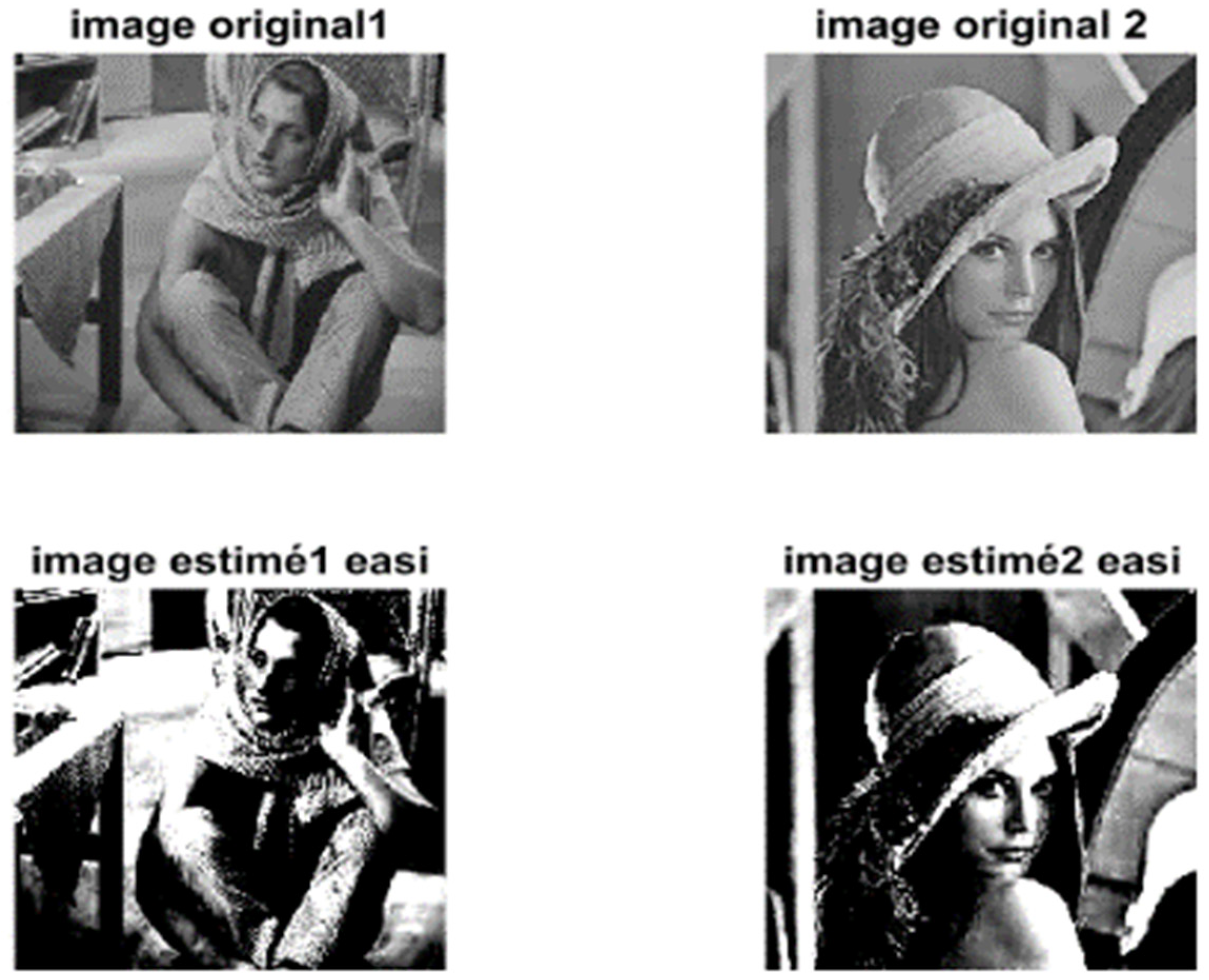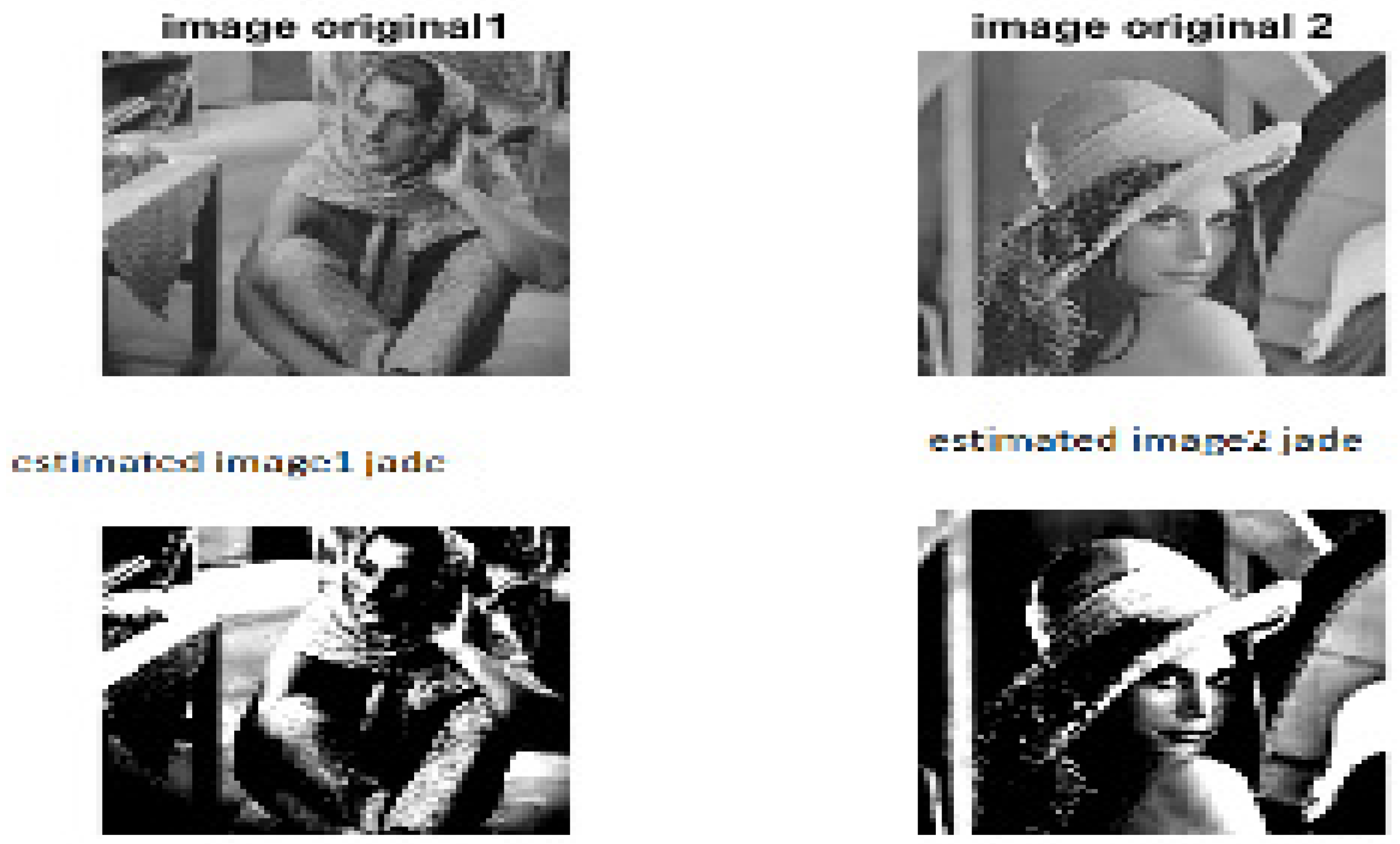Blind Image Separation Using the JADE Method †
Abstract
1. Introduction
2. BSS Model
2.1. Joint Approximate Diagonalization of Eigenmatrices
2.1.1. Whitening of
2.1.2. Cumulant Calculations
2.1.3. Decompose the Cumulants
2.1.4. Joint Diagonalization of the Eigenmatrices
2.2. Algorithm
- Normalize the N images.
- Mixed images are formed by linearly mixing with a random matrix.
- Initialization, estimate a Whitening matrix ,.
- Estimate a maximal set of cumulants matrix.
- Find the rotation matrix such that the simulants matrix are as diagonal as possible
- Estimate as, , and estimate the components as .
3. Simulation
4. Discussion
5. Conclusions
Author Contributions
Funding
Institutional Review Board Statement
Informed Consent Statement
Data Availability Statement
Conflicts of Interest
References
- Hesse, C.W.; James, C.J. On semi-blind source separation using spatial constraints with applications in EEG analysis. IEEE Trans. Biomed. Eng. 2006, 53, 2525–2534. [Google Scholar] [CrossRef] [PubMed]
- Kayabol, K.; Kuruoglu, E.E.; Sankur, B. Bayesian separation of images modeled with MRFs using MCMC. IEEE Trans. Image Process 2009, 18, 982–994. [Google Scholar] [CrossRef] [PubMed]
- Lin, Q.H.; Yin, F.L.; Zheng, Y.R. Secure image communication using blind source separation. In Proceedings of the IEEE 6th Circuits and Systems Symposium on Emerging Technologies: Frontiers of Mobile (IEEE Cat. No. 04EX710), Shanghai, China, 31 May–2 June 2004; pp. 261–264. [Google Scholar]
- Murata, N.; Ikeda, S. An on-line algorithm for blind source separation on speech signals. In Proceedings of the Nolta98, Crans-Montana, Switzerland, 14–17 September 1998; pp. 923–926. [Google Scholar]
- Jung, T.P.; Makeig, S.; Humphries, C.; Lee, T.W.; Mckeown, M.J.; Iragui, V.; Sejnowski, T.J. Removing electroencephalographic artifacts by blind source separation. Psychophysiology 2000, 37, 163–178. [Google Scholar] [CrossRef] [PubMed]
- Milles, J.; Van Der Geest, R.J.; Jerosch-Herold, M.; Reiber, J.H.; Lelieveldt, B.P. Fully automated motion correction in first-pass myocardial perfusion MR image sequences. IEEE Trans. Med. Imaging 2008, 27, 1611–1621. [Google Scholar] [CrossRef] [PubMed]
- Ichir, M.M.; Mohammad-Djafari, A. Hidden Markov models for wavelet-based blind source separation. IEEE Trans. Image Process. 2006, 15, 1887–1899. [Google Scholar] [CrossRef] [PubMed]
- Tonazzini, A.; Bedini, L.; Salerno, E. A Markov model for blind image separation by a mean-field EM algorithm. IEEE Trans. Image Process. 2006, 15, 473–482. [Google Scholar] [CrossRef] [PubMed]
- Huang, W.; Wu, S.; Kong, F.; Wu, Q. Research on Blind Source Separation for Machine Vibrations. Wirel. Sens. Netw. 2009, 1, 453–457. [Google Scholar] [CrossRef][Green Version]
- Yang, Y.; Wang, X.; Zhang, D. Blind Source Separation Research, based on the Feature Distance Using Evolutionary Algorithms. Int. J. Acoust. Vib. 2014, 19, 276. [Google Scholar] [CrossRef]
- Malhotra, R.; Singh, N.; Singh, Y. Genetic Algorithms: Concepts, Design for Optimization of Process Controllers. Comput. Inf. Sci. 2011, 4, 39. [Google Scholar] [CrossRef]
- Burke, E.K.; Burke, E.K.; Kendall, G.; Kendall, G. Search Methodologies, Introductory Tutorials in Optimization and Decision Support Techniques; Springer: Berlin, Germany, 2005; pp. 97–125. [Google Scholar]
- Zheng, P.; Liu, Y.; Tian, L.; Cao, Y. A Blind Source Separation Method Based on Diagonalization of correlation Matrices and Genetic Algorithm. In Proceedings of the Fifth World Congress on Intelligent Control and Automation, Hangzhou, China, 15–19 June 2004; Volume 3, pp. 2127–2131. [Google Scholar]
- Zhou, H.; Chen, C.Z.; Sun, X.M.; Liu, H. Research on Blind Source Separation Algorithm Based on Particle Swarm Optimization. Adv. Mater. Res. 2014, 989–994, 1566–1569. [Google Scholar] [CrossRef]
- Bai, Q. Analysis of particle swarm optimization algorithm. Comput. Inf. Sci. 2010, 3, 180. [Google Scholar] [CrossRef]
- Tripathi, P.K.; Bandyopadhyay, S.; Pal, S.K. Multi-Objective Particle Swarm optimization with time variant inertia and acceleration coefficients. Inf. Sci. 2007, 177, 5033–5049. [Google Scholar] [CrossRef]
- Ebrahimzadeh, A.; Mavaddati, S. A novel technique for blind source separation using bees colony algorithm. Elsevier Swarm Evol. Comput. 2014, 14, 15–20. [Google Scholar] [CrossRef]
- Rutledge, D.N.; Bouveresse, D.J. Independent components analysis with jade algorithm. Trac Trends Anal. Chem. 2013, 50, 22–32. [Google Scholar] [CrossRef]
- Jyothirmayi, M.; Kuzhali, E.S.; Selvi, S. Blind Source Separation Using Forward Difference Method (FDM). Signal Image Process. 2011, 2, 121. [Google Scholar]






| estimated image1 EASI | 6.4374 |
| estimated image2 EASI | 24.3083 |
| estimated image1 JADE | 17.3639 |
| estimated image1 JADE | 52.2668 |
| estimated image1 EASI | 18.5680 |
| estimated image2 EASI | 30.1416 |
| estimated image1 JADE | 31.0534 |
| estimated image2 JADE | 29.7526 |
Publisher’s Note: MDPI stays neutral with regard to jurisdictional claims in published maps and institutional affiliations. |
© 2022 by the authors. Licensee MDPI, Basel, Switzerland. This article is an open access article distributed under the terms and conditions of the Creative Commons Attribution (CC BY) license (https://creativecommons.org/licenses/by/4.0/).
Share and Cite
Ali, K.; Nourredine, A.; Elhadi, K. Blind Image Separation Using the JADE Method. Eng. Proc. 2022, 14, 20. https://doi.org/10.3390/engproc2022014020
Ali K, Nourredine A, Elhadi K. Blind Image Separation Using the JADE Method. Engineering Proceedings. 2022; 14(1):20. https://doi.org/10.3390/engproc2022014020
Chicago/Turabian StyleAli, Khalfa, Amardjia Nourredine, and Kenane Elhadi. 2022. "Blind Image Separation Using the JADE Method" Engineering Proceedings 14, no. 1: 20. https://doi.org/10.3390/engproc2022014020
APA StyleAli, K., Nourredine, A., & Elhadi, K. (2022). Blind Image Separation Using the JADE Method. Engineering Proceedings, 14(1), 20. https://doi.org/10.3390/engproc2022014020






